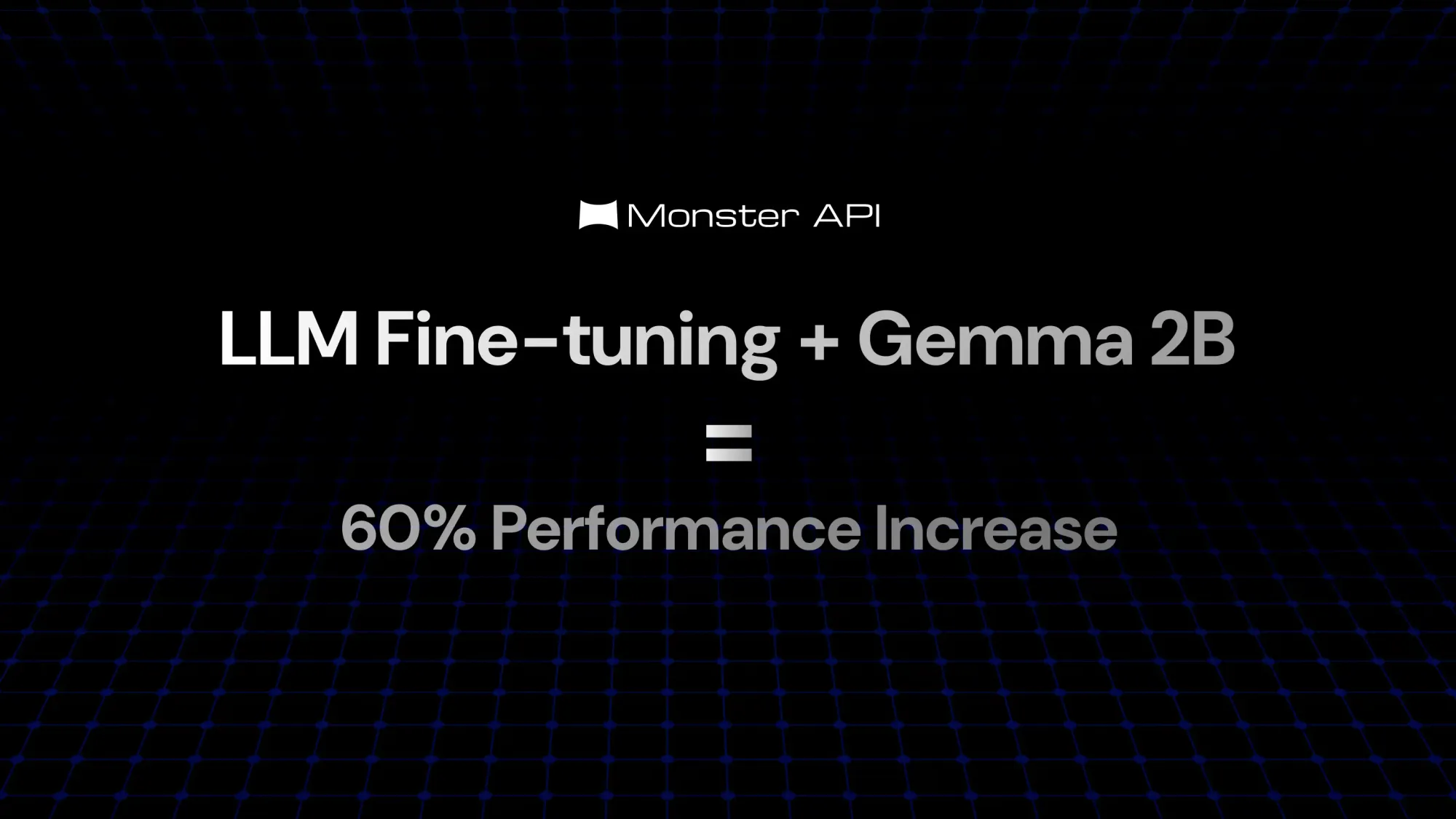Fine-tuning Google Gemma 2B: A Case Study in Model Finetuning and Optimization
In this guide, we're exploring the performance boost and optimization of Google's Gemma 2B base model by fine-tuning it using MonsterTuner.

In this case study, we explore how we took the Google Gemma 2B base model and fine-tuned it using advanced techniques, leading to improved performance across various benchmarks. Our experiment demonstrates the potential of smaller models when optimized effectively, rivaling the performance of larger, more resource-intensive models in specific tasks.
The Base Model: google/gemma-2-2b-it
We started with Google's Gemma 2B model, specifically the google/gemma-2-2b-it variant. This compact yet powerful language model is designed for instruction-following tasks. Part of the Gemma series, it's known for its efficiency and strong performance despite its relatively small size of 2 billion parameters.
Fine-Tuning Process
Using MonsterAPI's no-code LLM fine-tuner, MonsterTuner, we fine-tuned the Gemma 2B it model. The fine-tuning process was significantly enhanced by the use of a high-quality dataset known as "No Robots."
The Dataset: No Robots
"No Robots" is a carefully curated dataset consisting of 10,000 instructions and demonstrations created by skilled human annotators. This dataset is specifically designed for supervised fine-tuning (SFT) to improve language models' ability to follow instructions effectively.
Key features of the No Robots dataset:
- Modeled after the instruction dataset described in OpenAI's InstructGPT paper
- Comprises mostly single-turn instructions
- Covers a wide range of categories, ensuring broad applicability
Benchmarking Results and Comparison
To fully appreciate the impact of our fine-tuning process, let's compare the performance of our fine-tuned model "Gemma-2b-monsterapi" against the base models: google/gemma-2-2b-it and google/gemma-2-2b.
Price and Time Taken
- Price: The entire fine-tuning process was completed at a cost of $1.1, making it a highly affordable solution compared to larger models that require significantly higher investment.
- Time Taken: Fine-tuning was accomplished in just 31 mins, demonstrating an efficient approach that balances performance enhancements with rapid deployment capabilities.
Analysis of Results
- Overall Performance: Our fine-tuned model shows a significant improvement in average performance compared to the base google/gemma-2-2b model and closely rivals the instruction-tuned google/gemma-2-2b-it variant.
- BBH (Big-Bench Hard): Our fine-tuned model outperforms both base versions in complex reasoning tasks, demonstrating enhanced capabilities in challenging language tasks that require sophisticated reasoning.
- MUSR (Multi-Step Reasoning): The model shows significant improvement in multi-step reasoning tasks compared to both base versions, highlighting the effectiveness of our fine-tuning process in boosting the model’s complex reasoning skills.
These results demonstrate that our fine-tuning has successfully enhanced the model's capabilities in critical areas requiring complex and multi-step reasoning, especially when compared to the base google/gemma-2-2b model.
Key Takeaways
- Potential of Smaller Models: This experiment shows that even a 2B parameter model can achieve substantial improvements in complex reasoning tasks when fine-tuned effectively.
- Balanced Performance: The fine-tuned Gemma-2b-monsterapi model shows significant gains across complex reasoning benchmarks, indicating well-rounded enhancements.
- Resource Efficiency: Achieving these results with a 2B parameter model highlights the potential for cost-effective and computationally efficient AI solutions.
- Specialization vs. Generalization: The model demonstrates a good balance between specialized reasoning tasks (like MUSR) and broader complex reasoning (like BBH), reflecting successful transfer learning.
Applications and Future Work
The enhanced Gemma-2b-monsterapi model is particularly suited for scenarios where computational resources are limited, such as edge devices or real-time applications. Future enhancements could include:
- Further optimization of multi-step reasoning tasks.
- Exploring real-world applications where significant improvements were observed, particularly in complex reasoning tasks.
- Experimenting with advanced fine-tuning techniques to further push the model’s performance boundaries.
Conclusion
This case study highlights the effectiveness of fine-tuning smaller language models to enhance their performance in complex reasoning and multi-step problem-solving tasks. By using advanced fine-tuning techniques and high-quality data, we've shown that a 2B parameter model can compete with, and in some cases, outperform its base versions.
The Gemma-2b-monsterapi model showcases significant improvements in complex reasoning (BBH) and multi-step problem-solving (MUSR), proving that targeted fine-tuning can enhance specific capabilities without sacrificing the model's broad applicability.
Our successful experiment with the Gemma-2b-monsterapi underscores the value of high-quality training data and fine-tuning techniques, demonstrating the potential of compact models to deliver powerful and efficient AI solutions. This paves the way for more accessible AI technologies across various industries and applications.

